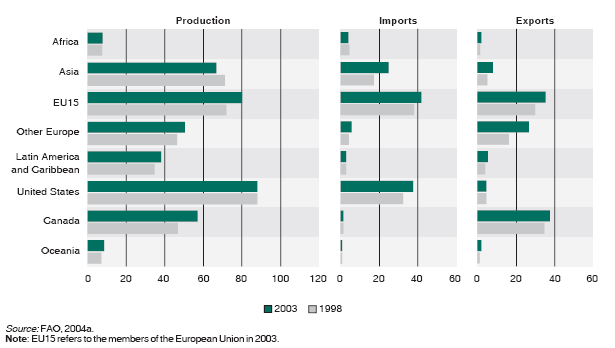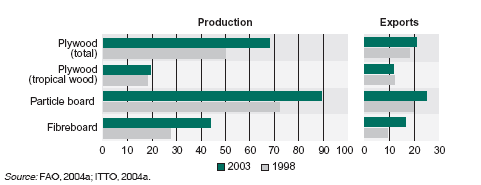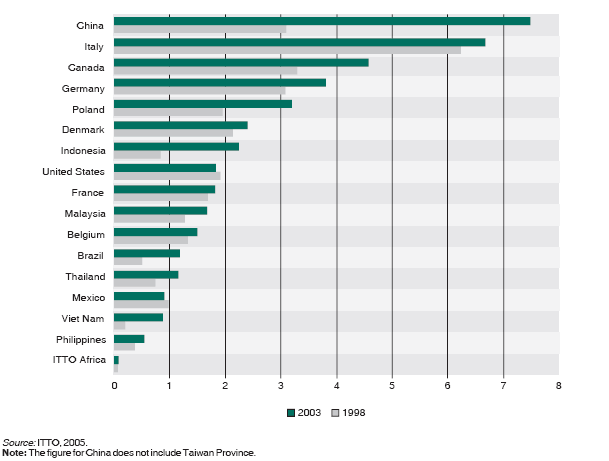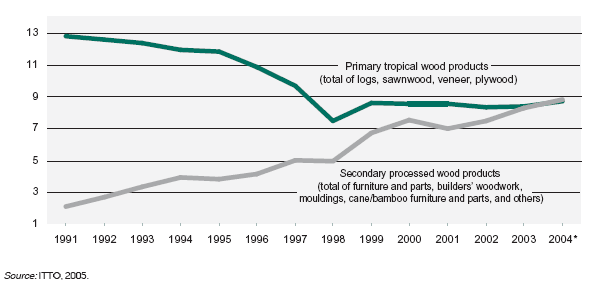


O. Hashiramoto, J. Castano and S. Johnson
Osamu Hashiramoto is Forestry Officer in the Forest Products and Economics Division, FAO Forestry Department, Rome, Italy.
J. Castano is Systems Analyst and
S. Johnson is Statistician in the Division of Economic Information and Market Intelligence, International Tropical Timber Organization (ITTO), Yokohama, Japan.
A review of recent trends in international trade in the main categories of wood products, with a focus on the emergence of new players.
The value of international trade in wood products reached US$150 billion in 2003. The global trade in wood products is highly regionalized, with Europe, North America and Asia accounting for 55, 25 and 11 percent, respectively, of the global export value of wood products in 2003 (FAO, 2004a).
In recent years, the global picture of trade in wood products has changed substantially with the emergence of China, the Russian Federation and eastern Europe as major traders. Traditional exporters of primary timber products in Southeast Asia have been changing into exporters of secondary processed products as a result of the development of processing industries and resource constraints. This article reviews recent trends in international trade in major wood products with a main focus on emerging countries, development of industries and environmental considerations.
Global trade of industrial roundwood has increased steadily, primarily owing to increases in temperate and boreal forest regions. Exports from the Russian Federation and central and eastern Europe have expanded particularly rapidly after a slump in production and trade in the early 1990s which accompanied the transition to a market economy (Figure 1). Russian export volumes have increased more than 80 percent in the past five years, reaching 37 million cubic metres in 2003, when they accounted for about 30 percent of global roundwood exports. The Russian Federation exports about 30 percent of its reported roundwood harvests. Major importers of Russian roundwood in 2003 were China, Finland, Japan, Sweden and the Republic of Korea (in descending order). More than 80 percent of Finland’s imported industrial roundwood comes from the Russian Federation (FAO, 2004a, 2004b).
Roundwood exports from the Baltic States (Estonia, Latvia and Lithuania), Belarus and Ukraine have also expanded rapidly as a result of higher prices in markets in other parts of Europe and privatization of forest lands in some countries. More than half of the exports of industrial roundwood from the Baltic States go to Sweden.
The increase in production and exports of wood in these regions, particularly from the Russian Federation to Asia and Europe, has raised environmental concerns, including reports of widespread illegal logging. It has been estimated that the total annual timber harvest in the Russian Federation is 20 to 30 percent higher than documented production, and that much of the undocumented production enters international trade (UNECE/FAO, 2004).
China’s imports of industrial roundwood increased more than three times between 1998 and 2003, when they exceeded 26 million cubic metres and made China the world’s largest importer of industrial roundwood. Imports from the Russian Federation surged because of development of the wood processing industry in China and logging restrictions implemented in 1998 to conserve domestic forests, together with the ready supply of timber from the Russian far east. China’s production of industrial roundwood declined from 107 million cubic metres in 1998 to 95 million cubic metres in 2003 (Figure 1).
China imported 7.6 million cubic metres of tropical roundwood in 2003, mainly from Malaysia, Gabon, Papua New Guinea, Liberia and Myanmar. This figure accounted for almost half of total imports by members of the International Tropical Timber Organization (ITTO). (The 59 ITTO members account for more than 90 percent of international trade in tropical timber.) Most of the tropical logs imported by China are transported to the southeast region of the country, which has developed into one of the world’s largest furniture and plywood production bases (ITTO, 2003, 2004a). China’s tropical log imports have increased more slowly than its coniferous log imports, but still grew by 60 percent between 1999 and 2003.
Brazil was the largest producer of tropical logs according to official 2003 data, surpassing Indonesia, although Indonesia’s total production may be substantially larger than shown in official figures. Malaysia is the third largest tropical log producer. Most of the logs harvested in Brazil and Indonesia are consumed domestically – although in Indonesia much of the “domestic consumption” refers to logs processed into products for export, such as plywood. Malaysia, Gabon and Papua New Guinea were the major exporters of tropical logs in 2003. Indonesia’s log exports were estimated at more than 3 million cubic metres in 2001 (ITTO, 2004a, based on trading partner reports), but had shrunken drastically by 2003 owing to enforcement of a log export ban. Indonesia has signed memoranda of understanding or other arrangements with major tropical log importing countries in an attempt to control illegal logging and trade of timber products. It reduced its logging quota (the quantity allotted for logging by the government) from 12 million cubic metres in 2002 to 5.74 million cubic metres in 2004, although the government intends to increase the quota to 20 to 30 million cubic metres in 2005 to bring production closer to capacity requirements. While progress has been made in generating political commitment to deal with illegal logging and trade, export and import figures for many significant timber traders (e.g. Indonesia and its main trading partners such as Malaysia and China) continue to show major discrepancies. Such discrepancies, if sustained over time, can be an indication of illegal trade and need to be investigated (Johnson, 2004).
 |
In Europe, exports of sawnwood from central and eastern Europe and the Commonwealth of Independent States to western European markets have increased rapidly (Figure 2). Major exporters include the Russian Federation, the Baltic States and Romania. Recent developments in the wood industry in these countries, fuelled by increasing investments from western and northern Europe, have improved the quality of products and the transportation infrastructure. Government policies have promoted foreign investments in some countries. Taking advantage of low production and raw material costs, these countries have expanded market share for their sawnwood in western Europe, and are competing with Nordic producers. Chinese companies are planning to invest in the wood processing industry in the Russian Federation, which should mean higher exports of sawnwood and other finished products from that country. With the emergence of these exporting countries, global competition has intensified. In response to concerns about resource conservation, many countries have started to seek forest certification to provide evidence of sustainable production to foreign buyers.
In North America, sawnwood flows from Canada to the United States increased in 2003 as a result of the strong domestic housing market, despite the weak United States dollar and ongoing anti-dumping tariffs and duties (UNECE/FAO, 2004). United States imports from some European countries (e.g. Germany, Sweden and Austria) and from some Southern Hemisphere countries (e.g. Brazil, Chile and New Zealand) have increased substantially. In Japan, sawnwood from Europe has expanded its market share, displacing Canadian, United States and tropical sawnwood.
In 2003, 4.2 million hectares of pine forests in British Columbia, Canada, were reportedly infested with mountain pine beetle, and up to 500 million cubic metres of dead timber is or will be available for salvage as a result (Natural Resources Canada, 2004). The salvage and subsequent milling of this timber will unquestionably have profound impacts on the international trade of sawnwood.
In the trade of tropical sawnwood, China was by far the world’s top importer in 2003. Thailand has increased imports of tropical sawnwood as its furniture industries have continued to grow. Malaysia is the largest tropical sawnwood exporter. In September 2004, Indonesia banned the export of rough sawnwood in view of continuing timber smuggling to neighbouring countries. Cameroon, Côte ďIvoire and Ghana are Africa’s main tropical sawnwood exporters.
Concern over resource sustainability has impacts on markets. Latin American trade in big-leaf mahogany (Swietenia macrophylla) has slowed significantly following the ban on logging, transportation, processing and trade of all mahogany products imposed by Brazil in 2001 and the inclusion of this species in Appendix II of the Convention on International Trade in Endangered Species of Fauna and Flora (CITES) in 2003. Peru’s exports of S. macrophylla increased following the Brazilian ban but have subsequently decreased as controls are implemented to conform with CITES and new forest management regulations in Peru. The reduction in supply of S. macrophylla has been reflected in the price of sawnwood not only of that species but also of African mahogany (Khaya spp.). Increasing demand for substitutes of S. macrophylla has also raised concern about their possible overexploitation among environmentalists (ITTO, 2004a).
 |
Production and trade of wood-based panels (veneer, plywood, particleboard, fibreboard, oriented strand board and other reconstituted panels) have been increasing in recent years (Figure 3). Production and trade of particleboard has been growing especially fast in western Europe and North America. Exports from Poland, the Czech Republic, Thailand and Malaysia have also increased.
Production and trade have grown faster for fibreboard than for any other category of wood-based panels. Trade of fibreboard, primarily medium density fibreboard, has almost doubled in the past five years. China increased its production by about five times in this period and became the largest producer, surpassing the United States. Major producers such as Germany, Canada and Poland also expanded production and exports. Production has also increased in many countries in the tropics or the Southern Hemisphere, such as Malaysia, Brazil, New Zealand, Australia, Chile and Indonesia (FAO, 2004a).
Plywood, particularly tropical plywood, has become less competitive against other wood panels (Figure 4). Indonesia, the largest exporter of plywood, reduced exports from 7.2 million cubic metres in 1998 to 5.5 million cubic metres in 2003, partly because of the reduction in logging quotas and legitimate log supplies referred to earlier. It is likely that issues related to uncertainty of log supply, lack of market transparency and subsequent price fluctuations also contributed to the decline in tropical plywood trade (ITTO, 2004b). The United States, the world’s largest plywood producer, has also decreased production. On the other hand, China has quadrupled its plywood production in the past five years, primarily using imported logs from tropical countries and radiata pine from New Zealand. China has developed a thriving plywood export market, expanding rapidly into large markets such as the Republic of Korea, Japan, the United States and Europe (in descending order). The Chinese industry has been successful in marketing “combi” plywood (products with a poplar core and a tropical wood face of okoumé [Aucoumea klaineana], meranti [Shorea spp.] or bintangor [Calophyllum spp.]). Low production costs and the relatively low value of the Chinese yuan (pegged for the past decade at 8.28 to the United States dollar) have benefited the export industry. Consequently, countries exporting tropical logs to China have been losing market share to that country in some plywood markets. This trend may be tempered by anti-dumping initiatives and questions of quality currently being raised about Chinese combi plywood in some importing countries.
Brazil and Chile are the major plywood producers in South America. Both have increased plywood production and exports in recent years. All of Chile’s plywood, and over half of Brazil’s, is produced from coniferous logs. Africa’s plywood exports, although very small compared with those of other regions, have grown in the past five years with increased exports from Cameroon, Côte ďIvoire and Ghana (ITTO, 2004a).
The price of plywood has, on average, been decreasing in recent years because of competition with other products and industrial overcapacity. In Europe, the reconstituted panel industry is also concerned about increasing competition for raw materials (e.g. wood chips and other residues) with the wood energy sector (UNECE/FAO, 2003).
 |
 |
Trade of paper, paperboard and pulp has increased steadily with a global increase in demand for paper products (Figure 5). In 2003, Europe had record production and trade levels. Shipments from major European exporting countries to Asian markets accounted for 38 percent of exports in 2003 and have increased by 48 percent since 2001. Paper and paperboard consumption in central and eastern Europe has been boosted by strong regional economic growth. This subregion was a net importer of both pulp and paper (UNECE/FAO, 2004). The Russian Federation increased production, imports and exports, although its production has not yet recovered to the levels of the late 1980s. China has increased production and imports of both pulp and paper. The United States, the largest producer and importer, has reduced production and increased imports in the past five years (FAO, 2004a).
Capital-intensive pulp and paper industries have developed in some countries in the tropics in the past decade. Brazil, Indonesia and Thailand are major producers and exporters of pulp and paper. India is important as both producer and importer. Brazil’s pulp production, based largely on pine and eucalyptus plantations, grew by almost 30 percent in the five years to 2003. Indonesia’s pulp industry, based on fast-growing plantations as well as natural forests, grew much faster. Some tropical countries have increased pulp imports because domestic forest resources are insufficient to meet paper-mill capacity. Although import substitution and export growth has been under way in some countries, tropical countries are, in aggregate, net importers of paper and paperboard (ITTO, 2004a).
 |
Most global trade in secondary processed wood products (SPWPs) such as wooden furniture and parts has traditionally taken place among developed countries in North America and western Europe. However, the production and export of SPWP from other regions has expanded at a rapid pace in the past decade (Figure 6). Indonesia, Malaysia, Brazil, Thailand, Mexico, Viet Nam and the Philippines are now major producers and exporters of SPWPs. Exports from these countries to the United States, the European Union and Japan have risen steadily since 1990, reaching almost US$8.6 billion in 2003. The trade of SPWPs among tropical countries has also been increasing.
Malaysia and Thailand have linked the development of their furniture industries to their rubberwood plantation resources. Introduction of new technologies and raw material supplies are allowing the use of a wider range of species in SPWP production (ITTO, 2005).
ITTO consumer countries have increased their imports of SPWPs from tropical countries at virtually the same rate as they have reduced their imports of primary tropical timber products, with the value of the former exceeding that of the latter for the first time in 2004 (Figure 7) (ITTO, 2005).
China has expanded its production and trade of SPWPs remarkably, more than doubling exports in the past five years. With SPWP exports valued at US$7.5 billion in 2003, it overtook Italy as the world’s largest exporter. Many companies from the United States, Taiwan Province of China, Singapore and other Asian countries have established SPWP joint ventures in special economic zones in southern China. Chinese manufacturers have been successful in penetrating high-value markets such as the United States (the destination of over 50 percent of its exports) and Japan (ITTO, 2005). China replaced Canada as the main supplier of SPWPs to the United States in 2003. As with plywood, low production costs and a favourable exchange rate made Chinese SPWPs more competitive. In response to complaints about the impacts of the rapid expansion of imports from China on domestic industry, the United States Department of Commerce imposed preliminary anti-dumping duties on some wooden bedroom furniture from China in June 2004 (UNECE/FAO, 2004). China has been Japan’s largest furniture supplier since 2000, when it replaced Thailand. Although China’s furniture exports are huge (almost 60 percent of total SPWP exports) and continue to grow, they account for only about 25 percent of production, with the balance absorbed by China’s large domestic market. Large-scale infrastructure projects and a lifting of the ban on private home ownership in 1998 have contributed to the expansion of domestic demand.
Viet Nam has recently become a competitive source of SPWPs, with exports growing more than fourfold in the past five years. With production costs that are even lower than in China, Viet Nam is attracting foreign investment even from investors in China. Vietnamese exports received a boost from a bilateral trade agreement signed with the United States in 2001.
In Latin America, the main SPWP exporters are Brazil and Mexico, which export mainly to the United States and Europe. A large part of these countries’ exports are produced from non-tropical coniferous wood. While Mexican exports have slowed since 2000, Brazil’s exports have almost doubled in the past five years. Most of Brazilian export furniture is made from solid pine and reconstituted panels from plantations in southern Brazil. In addition, Chile is an important exporter of mouldings to the United States and Japan.
Value-added processing in the African region, although still minor because of lack of capital and infrastructure, has been growing. Growth in production and trade of mouldings has been notable. Governments in many African countries such as Ghana, Côte ďIvoire, Nigeria and Cameroon are encouraging the development of secondary processing (ITTO, 2005). The region has prospects for access to European markets and for intraregional trade. Increasing production costs are encouraging European SPWP industries to outsource some production to Africa.
 |
 |
Several factors help explain the trends presented in this article. Production costs, exchange rates and investments in technology and infrastructure have substantial impacts on the production and trade of wood products. Conditions of forest resources, relevant government policies and factors affecting market access also contribute to observed changes.
Key developments in global forest products trade in recent years include the rise of China as both an importer and exporter, policy changes in the Russian Federation influencing global wood supply, and the transformation of many tropical countries into exporters of secondary processed wood products.
Competition has forced many developed countries to extend their wood products supply chains to regions where costs are lower. Resulting investments in the SPWP sector have led to a boom in exports from many developing countries and have contributed to increases in incomes, employment and technology transfer. The sustainable growth of further processing, which currently depends largely on timber plantations in many developing countries for raw materials, will also depend on new end-uses for lesser-used species, new techniques to meet technical and aesthetic requirements of markets and new technologies that make efficient use of smaller-dimension logs from fast-growing plantations.
Trade in wood products will continue to fluctuate with economic development and demand in different regions. Overcapacity of processing industries will continue to cause severe competition among producers of some products. Increasingly stringent forest management standards resulting from resource concerns will influence trade flows both by affecting the supply of raw material available to industry and by making products more acceptable to environmentally discerning markets.
 Bibliography
Bibliography
FAO. 2004a. FAOSTAT Forestry data. Rome. Available at: faostat.external.fao.org/faostat/collections?subset=forestry
FAO. 2004b. FAO Yearbook of Forest Products 2002. Rome.
International Tropical Timber Organization (ITTO). 2003. Annual Review and Assessment of the World Timber Situation 2002. Yokohama, Japan.
ITTO. 2004a. Annual Review and Assessment of the World Timber Situation 2003. Yokohama, Japan.
ITTO. 2004b. Reviving tropical plywood, by L. Rutten & S.H. Tan. ITTO Technical Series No. 20. Yokohama, Japan.
ITTO. 2005. Annual Review and Assessment of the World Timber Situation 2004. Yokohama, Japan. (In press).
Johnson, S. 2004. Overview of ITTO’s work related to illegal logging and illegal timber trade. Presentation at the International Conference on the Future of Forests in East Asia and China: New Markets for Ecosystem Services/Trends in Regional Forest Trade and Finance. Kuala Lumpur, Malaysia, 7–8 October.
Natural Resources Canada. 2004. The State of Canadian Forests 2003–2004. Ottawa, Canada.
United Nations Economic Commission for Europe (UNECE)/FAO. 2003. Forest Products Annual Market Analysis 2002–2004. Timber Bulletin, Vol. 56. ECE/TIM/BULL/2003/3.
UNECE/FAO. 2004. Forest Products Annual Market Review 2003-2004. Timber Bulletin, Vol. 57. ECE/TIM/BULL/2004/3.